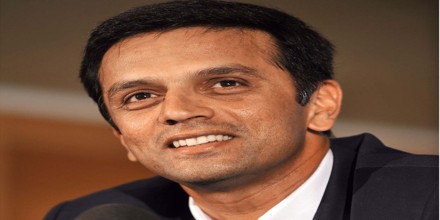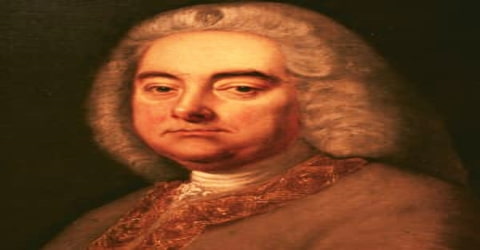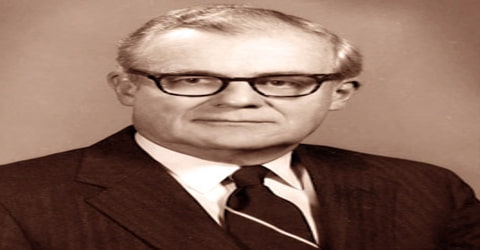Rahul Dravid – Former Indian Cricketer and Captain
Full name: Rahul Sharad Dravid
Nickname: The Wall, Jammy, Mr. Dependable
Date of birth: 11 January 1973 (age 44)
Place of birth: Indore, Madhya Pradesh, India
Height: 5 ft 11 in (1.80 m)
Batting style: Right-handed
Bowling style: Right arm off spin
Role: Batsman, occasional wicketkeeper, Coach
Spouse: Vijeta Pendharkar (m. 2003)
Children: Samit Dravid, Anvay Dravid
Early Life

Rahul Sharad Dravid was born on 11 January 1973, in Indore, Madhya Pradesh, India. He is a former cricketer who represented the Indian national cricket team. Other than being a stylish batsman in the top order of the Indian cricket team, Rahul Dravid has the record of taking the maximum number of catches in test cricket.
He started playing cricket at the age of 12 and later represented Karnataka at the under-15, under-17 and under-19 levels. Hailed as The Wall, Dravid was named one of the best five cricketers of the year by Wisden Cricketers’ Almanack in 2000 and received the Player of the Year and the Test Player of the Year awards at the inaugural ICC awards ceremony in 2004. In December 2011, he became the first non-Australian cricketer to deliver the Bradman Oration in Canberra.
As of December 2016, Dravid is the fourth-highest run scorer in Test cricket, after Sachin Tendulkar, Ricky Ponting and Jacques Kallis, and is only the second Indian cricketer, after Tendulkar to score 10,000 runs both in Tests and in ODIs. In 2004, after completing his century against Bangladesh in Chittagong, he became the first and the only player till date to score a century in all the ten Test-playing countries. As of October 2012, he holds the record for the most number of catches taken by a player (non-wicket-keeper) in Test cricket, with 210. Dravid holds a unique record of never getting out for a Golden duck in the 286 Test innings which he has played.
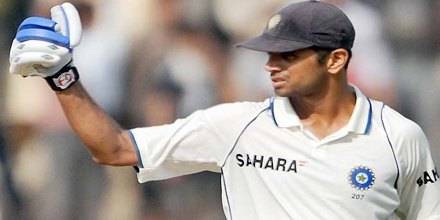
He retired from all forms of international cricket on March 9, 2012 with an illustrious career which spanned 16 years.
Rahul Dravid, along with Glenn McGrath were honoured during the seventh annual Bradman Awards function in Sydney on 1 November 2012. Dravid has also been honoured with the Padma Shri and the Padma Bhushan award, India’s fourth and third highest civilian awards respectively.
In 2014, Rahul Dravid joined the GoSports Foundation, Bangalore as a member of their board of advisors. In collaboration with GoSports Foundation he is mentoring India’s future Olympians and Paralympians as part of the Rahul Dravid Athlete Mentorship Programme. Indian badminton player Prannoy Kumar, Para-swimmer Sharath Gayakwad and young Golfer Chikkarangappa S. was part of the initial group of athletes to be mentored by Rahul Dravid.
Childhood and Educational Life
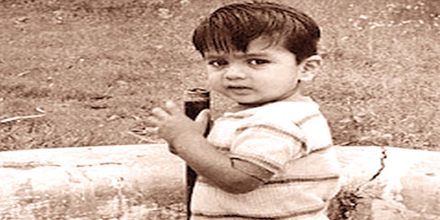
Rahul Dravid was born on January 11, 1973 to Maharashtrian parents Sharad Dravid and Pushpa Dravid in Indore, Madhya Pradesh. His father was an employee of Kissan and his mother Pushpa was employed as a professor of architecture at Bangalore University. He has a younger brother whose name is Vijay Dravid. During the early days of his student life, Rahul Dravid studied at St. Joseph’s Boys’ High School in Bangalore. He did his graduation in Commerce from St. Joseph’s College of Commerce, Bangalore.
He was selected to India national cricket team while studying MBA in St Joseph’s College of Business Administration.
Personal Life

On 4 May 2003 he married Vijeta Pendharkar, a surgeon from Nagpur. They have two children: Samit, born in 2005, and Anvay, born in 2009. Rahul can proficiently speak Marathi, Hindi, Kannada and English.
Playing Career
Rahul began playing cricket when he was just 12 years old. He played for the state of Karnataka at different levels such as under-15, under-17 and under-19 level. A former member of the Indian cricket team, Keki Tarapore identified his batting prowess when he was training budding cricketers at the Chinnaswamy Stadium in Bangalore. When Dravid first played for his school team, he made a hundred. Other than batting for his school team, he also did wicket keeping. Nonetheless, Dravid refrained from wicket keeping when he received tips from Roger Binny, Gundappa Vishwanath, Keki Tarapore, and Brijesh Patel who at different times represented the Indian cricket team.
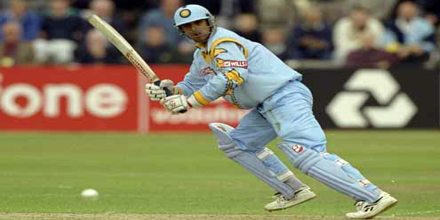
Dravid made his Ranji Trophy debut in February 1991, while he was still attending college. Playing alongside future Indian teammates Anil Kumble and Javagal Srinath against Maharashtra in Pune, he scored 82 runs in the match, which ended in a draw. His first full season was in 1991–92, when he scored two centuries and finished up with 380 runs at an average of 63.3, getting selected for the South Zone cricket team in the Duleep Trophy.
Dravid made his international debut against Sri Lanka in a one day series in Singapore in 1996. In contrast to his ODI debut, his Test debut was rather successful one. Dravid was selected for the Indian squad touring England on the backdrop of a consistent performance in domestic cricket for 5 years. Fine performances in the tour games including fifties against Gloucestershire and Leicestershire failed to earn him a place in the team for the First Test. He finally made his Test debut at Lord’s on 20 June 1996 against England in the Second Test of the series at the expense of injured senior batsman Sanjay Manjrekar. Manjrekar, who was suffering from an ankle injury, was to undergo a fitness test on the morning of the Second Test.
He made his test debut together with Sourav Ganguly versus England. He played prolifically and there was no looking back for this cricketer.

After a successful Test debut in England, Dravid played the one-off Test against Australia in Delhi – The first edition of Border-Gavaskar Trophy and his first test in India. Batting at no.6, he scored 40 runs in the First innings. Dravid batted at no. 3 position for the first time in the First Test of the three match home series against South Africa in Ahmedabad in November 1996. He was then promoted to the opening slot in the Second Test and later demoted in the batting order for the Third Test. He didn’t do too well in the series scoring just 175 runs at an average of 29.16 and was the third best Indian batsman in the series. India won the series 2–1.
He made his first test century against South Africa in the 1996-1997 tour. Dravid carried the good form from South Africa to the West Indies where he once again top scored for India in the five match Test series. He scored 360 runs at an average of 72.00 including four fifties. He topped the international runs chart for the 1996/97 season with 852 runs from 12 matches at an average of 50.11 with six fifties and one hundred.
He continued his good run in Tests scoring seven fifties in next eight Tests which included 6 fifties in consecutive innings (3 each against Sri Lanka and Australia), becoming only the second Indian to do so after Gundappa Vishwanath. Although he fared poorly in the 2-match Test series played in Sri Lanka, he made up for it in the 3-match home series against the same opponents where he scored 304 runs at an average of 76.00. By the end of 1997/98 Test season, he had scored 15 fifties in 22 Tests which included four scores of nineties but just a solitary hundred.

First Test (India vs New Zealand) having been abandoned without a ball bowled, the series started for Dravid with the first duck of his Test career in the first innings of the Second Test and ended with hundreds in each innings of the Third Test in Hamilton. He scored 190 and 103 not out in the first and the second innings respectively, becoming only the third Indian batsman, after Vijay Hazare and Sunil Gavaskar, to score a century in both innings of a Test match. During his innings of 190, he put up a record 144 run partnership against New Zealand for 8th wicket with Javagal Srinath. The match ended in a draw.
List of International centuries by Rahul Dravid
Test Centuries by Rahul Dravid
- 148 Versus South Africa at New Wanderers Stadium, Johannesburg
- 118 versus Zimbabwe at Harare Sports Club, Harare
- 190 versus New Zealand at WestpacTrust Park, Hamilton
- 103 not out versus New Zealand at WestpacTrust Park, Hamilton
- 107 against Sri Lanka at Sinhalese Sports Club Ground, Colombo
- 144 against New Zealand at Punjab Cricket Association Stadium, Mohali, Chandigarh
- 162 versus Zimbabwe at Vidarbha Cricket Association Ground, Nagpur
- 200 not out versus Zimbabwe at Feroz Shah Kotla, Delhi
- 180 versus Australia at Eden Gardens, Kolkata
- 144 not out versus West Indies at Bourda, Georgetown, Guyana
- 115 versus England at Trent Bridge, Nottingham
- 148 versus England at Headingley, Leeds
- 217 against England at Kennington Oval, London
- 100 not out against West Indies at Wankhede Stadium, Mumbai
- 222 versus New Zealand at Sardar Patel Stadium, Motera, Ahmedabad
- 233 versus Australia at Adelaide Oval
- 270 against Pakistan at Rawalpindi Cricket Stadium
- 160 versus Bangladesh at MA Aziz Stadium, Chittagong
- 110 against Pakistan at Eden Gardens, Kolkata
- 135 versus Pakistan at Eden Gardens, Kolkata
- 128 not out against Pakistan at Gaddafi Stadium, Lahore
- 103 versus Pakistan at Iqbal Stadium, Faisalabad
- 146 versus West Indies at Beausejour Stadium, Gros Islet, St. Lucia
- 129 against Bangladesh at Shere Bangla National Stadium, Mirpur
- 111 versus South Africa at MA Chidambaram Stadium, Chepauk, Chennai
- 136 versus England at Punjab Cricket Association Stadium, Mohali, Chandigarh
- 177 against Sri Lanka at Sardar Patel Stadium, Motera, Ahmedabad
- 144 against Sri Lanka at Green Park, Kanpur, India
- 111 not out against Bangladesh at Sher-e-Bangla Cricket Stadium, Mirpur Thana, Dhaka
- 104 against New Zealand at Sardar Patel Stadium, Motera, Ahmedabad
- 191 versus New Zealand at Vidarbha Cricket Association Stadium, Jamtha, Nagpur
- 112 versus West Indies at Sabina Park, Kingston, Jamaica
- 103 not out against England at Lords, London
- 117 against England at Trent Bridge, Nottingham
- 146 against England at The Oval, London
- 119 versus West Indies at Eden Gardens, Kolkata
Dravid scored his first half century in ODIs against Pakistan when he was playing for Sahara Cup. He is the third batsman of the Indian cricket team to make hundreds in both innings of a test match following Sunil Gavaskar and Vijay Hazare and he achieved the feat against New Zealand.

On the 1996 India tour of England, he wasn’t picked up for the first two games of the Texaco Trophy, but got a chance in the third ODI where he scored some quick runs towards the end of the innings, scoring 22 not out from 15 balls. India then went on to play a quadrangular series in Sri Lanka where Dravid could manage only 20 runs in two innings.
Following the Sahara cup, India played two triangular series- one involving Australia and South Africa in India and the other involving South Africa and Zimbabwe in South Africa.
The two triangular series were played as a part of back-to-back home and away series between India and South Africa in 1996/97. India also played a Mohinder Amarnath Benefit Match against South Africa in Mumbai sandwiched between the two triangular series. Dravid played in all the games. He was the third highest run scorer for India in Indian leg of ODI series, much like the Indian leg of Test series. Like the South African leg of test series, Dravid emerged as the top scorer for India in the South African leg of ODI series as well. Despite Dravid’s Man of the Match winning effort of 84 runs, India lost the Final to South Africa.
Dravid scored his first ODI hundred in the Independence Cup against Pakistan in Chennai. Unfortunately, his maiden ODI hundred came in a losing cause. Dravid top scored for India in the quadrangular event with 189 runs at an average of 94.50 however, India failed to qualify for the Finals.
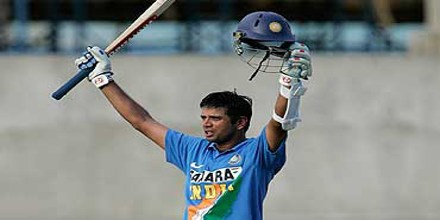
He accompanied the team to the 1997/98 Akai-Singer Champions Trophy but did not get a chance to play the first two games. He was then picked up for the third game only to be dropped again from the Indian ODI squad for the rest of the ODI season.
By the end of 1998, Dravid had scored 1709 runs in 65 ODIs at an average of 31.64 with a poor strike rate of 63.48.
Dravid scored a hundred against Sri Lanka in 1998/99 Pepsi Cup at Nagpur adding a record 236 runs for the 2nd wicket with Ganguly, who also scored a hundred in the match. Uncharacteristically, Dravid was the faster of the two scoring 116 of 118 deliveries. In the next match against Pakistan, he bowled four overs and took the wicket of Saeed Anwar; his first wicket in International cricket. He ended up as the third highest scorer for India in the tournament.
Before Indian team departed for England to participate in the 1999 World Cup, they played a friendly game with 1983 World Cup winning team. Although Dravid scored just 20 runs, he took two wickets dismissing Dilip Vengsarkar and Roger Binny.
In the 1999 ICC Cricket World Cup, he finished top scorer with 461 runs. He is the only Indian batsman to score two consecutive centuries in this tournament. The 180 runs he scored against Australia in the second test at the Eden Gardens in 2001 is regarded as one of the most memorable innings that he played for India. During 2003-2004, Dravid made three double centuries, against Australia, New Zealand, and Pakistan. He played his last one day international against England in September 2011 and played his last test match against Australia in the 2011-2012 season. However, he will continue to play for the IPL (Indian Premier League) and represent the Rajasthan Royals Team.
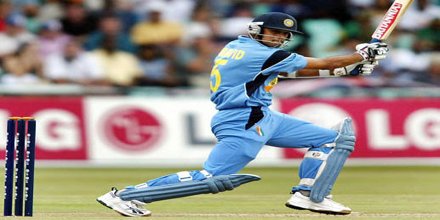
Dravid is known for his technique, and had been one of the best batsmen for the Indian cricket team. In the beginning, he was known as a defensive batsman who should be confined to Test cricket, and was dropped from the ODI squad due to a low strike rate. However, in a period of his career, he began consistently scoring runs in ODIs as well, earning him the ICC Player of the year award. His nickname of ‘The Wall’ in Reebok advertisements is now used as his nickname. Dravid has scored 36 centuries in Test cricket at an average of 53.19; this included five double centuries. In one-dayers, he has an average of 39.49, and a strike rate of 71.22. He is one of the few Indians whose Test average is better at away than at home, averaging almost five runs more in foreign pitches. As of 23 September 2010, Dravid’s Test average in abroad is 55.53, and his Test average at home is 50.76; his ODI average abroad is 37.93 and his ODI average at home is 43.11. Taking those matches in consideration that were won by India, Dravid averages 66.34 runs in Tests and 50.69 runs in ODIs.
One Day International Centuries by Rahul Dravid
- 107 against Pakistan at MA Chidambaram Stadium, Chepauk, Chennai
- 123 not out against New Zealand at Owen Delany Park, Taupo
- 116 against Sri Lanka at Vidarbha Cricket Association Ground, Nagpur
- 104 not out against Kenya at County Ground, Bristol
- 145 against Sri Lanka at County Ground, Taunton
- 103 not out against West Indies at Kallang Ground, Singapore
- 153 against New Zealand at Lal Bahadur Shastri Stadium, Hyderabad, Deccan
- 109 not out against West Indies at Sardar Patel Stadium, Motera, Ahmedabad
- 104 versus United Arab Emirates at Rangiri Dambulla International Stadium
- 104 against Pakistan at Nehru Stadium, Kochi
- 103 not out against Sri Lanka at Sardar Patel Stadium, Motera, Ahmedabad
- 105 against West Indies at Sabina Park, Kingston, Jamaica
Awards and Achievements by Rahul Dravid
He received the Arjuna award in 1998
He received the Ceat Cricketer of the 1999 World Cup in 1999
He was nominated as Wisden Cricketer of the Year 2000 in the year 2000
He received the Sir Garfield Sobers Trophy Winner (Honored for ICC Player of the Year) in 2004
He received the Padma Shri Award in 2004
He was nominated as the ICC Test Player of The Year in 2004 and also MTV Youth Icon of the Year in the same year
He was made captain of the Test Team of the International Cricket Council in 2006
He received the NDTV Indian of the Year’s Lifetime Achievement Award in 2011 with Dev Anand
